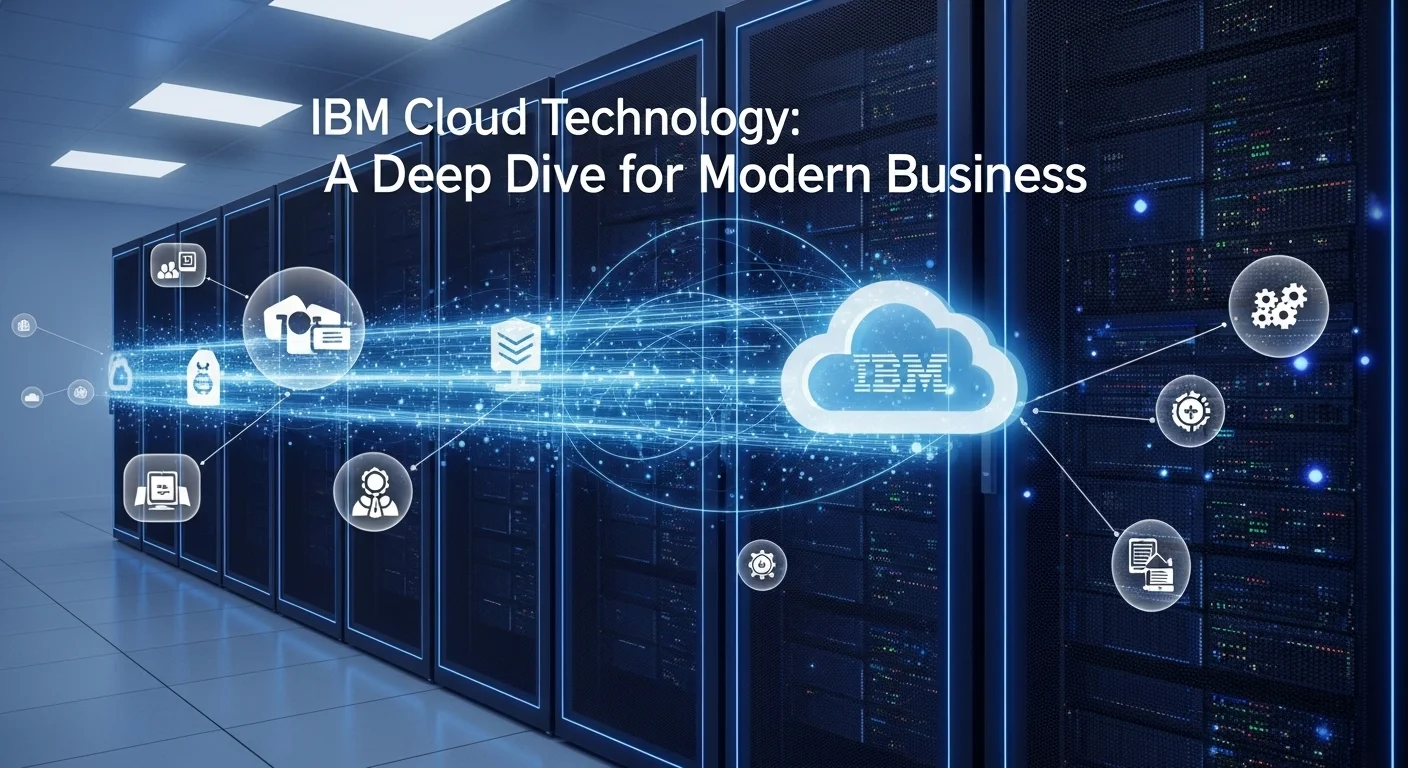IBM Cloud Demystified: A Hands-On Guide for Your Business

Executive Summary
In a world buzzing with cloud options, it's easy to get lost. As someone who has spent years navigating these digital landscapes for businesses, I've seen firsthand how IBM Cloud has carved out its unique space. It’s not just another cloud provider; it’s a powerhouse for companies that need serious security, hybrid flexibility, and powerful AI. This article isn't a dry technical manual. It's my personal walkthrough of what makes IBM Cloud tick—from its core computing services and robust networking to its forward-thinking strategy. I'll share what I've learned to help you understand if this platform is the right partner to drive your innovation, secure your operations, and achieve your most ambitious goals.
Table of Contents
Table of Contents
- What Is IBM Cloud, Really?
- Why It's a Game-Changer for Enterprises
- A Look at the Core Components and Their Uses
- The IBM Difference: More Than Just a Provider
- What's In It for You? Benefits for Businesses and Developers
What is IBM Cloud and why is it important in Technology?
In today's world, the cloud is no longer optional—it's the engine of modern business. Among the big names, IBM Cloud has a unique story. I remember when IBM acquired SoftLayer back in 2013 and later integrated its Bluemix platform. It was a clear signal they were serious about building a unified, enterprise-first cloud. Today, IBM Cloud is a massive suite of services, offering everything from basic infrastructure (IaaS) and development platforms (PaaS) to ready-to-use software (SaaS). It’s designed to be a one-stop shop for businesses of all sizes, but it's where it truly shines for large, complex organizations.
So, why should you pay attention to it? For me, two things stand out. First, its deep commitment to hybrid and multicloud environments. I've worked with countless companies, and almost none of them live in a single cloud. They have their own data centers, some services with AWS, others with Azure. IBM’s strategy is built for this reality. With tools like IBM Cloud Satellite and Red Hat OpenShift, you can manage all these different pieces from one place. This means you can build an application once and run it anywhere, which is a massive win for flexibility and avoiding being locked into one vendor. It's the key to modernizing your business without having to tear everything down and start over.
Second is IBM's legacy and expertise in security and regulated industries. This isn't just a marketing line. The platform is built from the ground up with security at its core, which is why it’s a go-to for sectors like finance, healthcare, and government. They offer specialized tools like the IBM Cloud Framework for Financial Services, which helps meet tough compliance rules. Advanced features like 'Keep Your Own Key' (KYOK) for encryption give businesses total control over their data. In my experience, this focus on security provides a level of confidence that is essential when you're running mission-critical applications.
Core Components and Business Applications
To really get a feel for IBM Cloud, you need to understand its building blocks. It’s broken down into a few key areas that every business needs.
Compute Services: This is the horsepower. IBM gives you a lot of choices here. You can get bare-metal servers for raw, dedicated performance—perfect for huge databases or high-performance computing. Or you can use virtual servers for everyday flexible workloads. They even have serverless computing with IBM Cloud Functions for tasks that only run when needed. This range means you can pick the right tool for the right job, every time.
Storage Solutions: Every business runs on data, and IBM offers a full menu of storage options. There's object storage for all your unstructured files, block storage for high-speed database access, and file storage for shared network drives. They've built it to be secure and cost-effective, with smart features like tiered storage that automatically move less-used data to cheaper options.
IBM Cloud Networking: A fast and secure network is the nervous system of your cloud setup. IBM's networking services are designed for high performance and strong security. You can create your own isolated network with Virtual Private Cloud (VPC), use load balancers to keep your apps running smoothly, and create a private, dedicated connection to your own data center with IBM Cloud Direct Link. It’s a solid foundation for any serious cloud deployment.
AI and Machine Learning: This is where things get exciting. IBM has woven its powerful Watson AI throughout the platform. You can easily add things like conversational chatbots (Watson Assistant) or intelligent data analysis (Watson Discovery) to your applications. It’s not just for developers, either. The platform uses AI for its own operations, helping to automate IT tasks and spot problems before they happen.
The Role of IBM as a Cloud Service Provider
What makes IBM different as a cloud provider is its deep industry knowledge and partnership approach. They don't just sell you technology; they offer solutions tailored for over 20 different industries. Their teams of experts work with clients to design and manage cloud environments, which is incredibly valuable for large companies going through a digital transformation.
The $34 billion acquisition of Red Hat was a game-changer. It put open-source technology, especially Red Hat OpenShift, right at the heart of their hybrid cloud vision. This solidified their commitment to an open, flexible cloud world. The IBM Cloud Paks, which are essentially pre-packaged software solutions built on OpenShift, offer a faster and more secure way to move your core business applications to any cloud. These Paks cover everything from data and automation to security, giving you a head start on modernization.
Furthermore, IBM's cloud is defined by its focus on enterprise-level performance. Their global network of data centers ensures your applications are fast and available everywhere. The continued emphasis on bare-metal servers is a key differentiator, providing unmatched power for the most demanding workloads. This focus on high-performance, secure, and flexible infrastructure is why so many businesses trust IBM with their most important systems.
What's In It for You? Benefits for Businesses and Tech Enthusiasts
For businesses, the benefits are clear. You get to innovate faster while managing risk. The hybrid model lets you modernize at your own pace, leveraging the public cloud's power while keeping sensitive data secure on-premises. This leads to more agility and better use of your resources. The strong security features also take a huge weight off your internal teams.
Cost is always a factor, and IBM provides great tools for managing your cloud spending. You can track everything, cut out waste, and make sure you're only paying for what you use. For tech folks and developers, IBM Cloud is a fantastic playground. It's built on open-source tools like Kubernetes, so you can use the languages you already know, like Java, Python, and Node.js. The free tier is generous, letting you experiment with everything from AI to quantum computing. It's a platform that truly empowers you to build the next big thing.

Complete guide to IBM Cloud in Technology and Business Solutions
To truly harness IBM Cloud, you need to look beyond the marketing and understand how to align its technical power with your business goals. This guide is my attempt to give you that deeper perspective, covering the architecture, effective business strategies, and how it stacks up against the competition. Let's equip you to use this platform not just for technology, but for real, sustainable growth.
Technical Deep Dive: Architecture and Services
At its heart, IBM Cloud is built for flexibility and security. Its global network of data centers is designed with high availability in mind, and one of its core principles is separating network traffic for public, private, and management tasks. For anyone who's managed enterprise IT, you know how critical that separation is for security.
Infrastructure as a Service (IaaS)
This is the foundation. I've always appreciated that IBM offers a clear choice between virtual servers and bare-metal servers. Virtual servers are great for everyday workloads that need to scale up and down. But for the heavy hitters—large databases, high-performance computing, or AI training—nothing beats bare-metal. You get direct access to the physical hardware, which means consistent, top-tier performance. It’s a major advantage for applications where performance is non-negotiable.
Platform as a Service (PaaS)
This is where your developers live. IBM's PaaS is powered by Red Hat OpenShift, the gold standard for enterprise Kubernetes. This is the centerpiece of their hybrid cloud strategy. It gives you a consistent platform to build, deploy, and manage containerized applications anywhere—on your own servers, in IBM Cloud, or even on AWS or Azure. This container-based approach lets you build with microservices, making your applications more agile, scalable, and resilient. It's how modern software is built.
Key IBM Cloud Computing Services
Beyond the basics, here are a few services that I've found to be particularly impactful:
- IBM Watson AI: This isn't just one tool; it's a whole suite that makes AI accessible. I've seen businesses use Watson Assistant to build incredibly smart chatbots and Watson Discovery to pull amazing insights from mountains of unstructured data. It puts world-class AI in your hands.
- IBM Cloud Databases: The platform offers a huge variety of databases, from traditional ones like Db2 to modern NoSQL options like MongoDB and Cloudant. This means your developers always have the right database for the job, whatever the data model.
- IBM Cloud Satellite: This service is a genuine game-changer for hybrid cloud. It lets you create an IBM Cloud 'location' anywhere—in your data center, at an edge location, or in another cloud. You can then manage all of it from a single IBM Cloud console. It's the ultimate 'single pane of glass' for hybrid environments.
- IBM Blockchain Platform: For companies exploring blockchain, IBM provides a powerful and secure platform that simplifies the whole process of building and governing a blockchain network.
Business Techniques: Crafting a Winning IBM Cloud Strategy
Choosing a cloud platform is a major business decision. A successful strategy aligns the technology with your goals. Here’s what I’ve seen work best:
1. Embrace a Hybrid and Multicloud World
Don't go 'all-in' on a single cloud unless you have a very specific reason. The smartest approach for most businesses is a hybrid, multicloud model. Figure out which applications are best for the public cloud, which need to stay on-premises for security or latency reasons, and where other clouds fit in. IBM's platform, with tools like OpenShift and Satellite, is perfectly designed for this. A thorough workload assessment is your first step to creating a smart migration plan.
2. Make Security Job Zero
In today's world, you can't bolt on security at the end. With IBM, you should lean into its security strengths from day one. This means adopting a 'zero-trust' model and using the platform's security tools. Enforce strict access policies with IAM, encrypt all your data, and use the Security and Compliance Center to constantly monitor your setup. For your most sensitive data, using 'Keep Your Own Key' (KYOK) gives you ultimate peace of mind.
3. Build a FinOps Culture to Manage Costs
Cloud bills can get scary without discipline. I always advise my clients to set up a FinOps (Cloud Financial Operations) practice. This gets your finance, tech, and business teams talking the same language about cloud costs. Use tools like IBM Cloud Cost Management to see where your money is going, tag all your resources to allocate costs properly, and hunt for savings. Simple things like right-sizing your virtual machines and using autoscaling can save you a fortune.
Available Resources and Comparisons
IBM offers a ton of resources, from documentation and tutorials to their hands-on IBM Cloud Garage, where you can build innovative apps side-by-side with their experts.
When clients ask me how IBM Cloud compares to AWS, Azure, and Google Cloud, here’s how I break it down:
- vs. AWS: Amazon is the market leader with an enormous list of services. But I find IBM often has the edge in hybrid cloud management, bare-metal performance, and deep security for regulated industries. While AWS has hybrid offerings, IBM's strategy around Red Hat OpenShift feels more open and less vendor-specific.
- vs. Azure: Microsoft's big advantage is its tight integration with its own software stack (Windows Server, Office 365). If you're a Microsoft shop, Azure is a very natural choice. IBM stands out with its stronger multicloud story and its expertise in specific industries like finance.
- vs. GCP: Google is a master of data analytics, machine learning, and Kubernetes. If you're a data-heavy, cloud-native company, GCP is a fantastic choice. IBM competes with its enterprise focus, robust security posture, and comprehensive hybrid solutions that are tailored to the complexities of large, established organizations.
The Role of IBM Cloud Networking
Never underestimate the importance of networking. A solid network is the foundation of everything else. IBM's networking services provide a secure, high-performance global backbone. With Virtual Private Cloud (VPC), you can create your own isolated slice of the cloud. For connecting to your own data centers, IBM Cloud Direct Link provides a private, reliable connection that's essential for any serious hybrid setup. And for your public-facing apps, services like IBM Cloud Internet Services protect you from attacks and speed up performance. A well-designed network on IBM Cloud is the secret to a secure, high-performing, and successful deployment.

Tips and strategies for IBM Cloud to improve your Technology experience
Getting the most out of a platform like IBM Cloud is about more than just using its services; it's about using them smartly. Over the years, I've gathered a set of best practices and strategies that have consistently helped my clients improve performance, tighten security, and get a better handle on costs. Here are some of my go-to tips to enhance your experience.
Best Practices for Security and Compliance
I can't stress this enough: security in the cloud is a partnership. IBM handles the infrastructure, but you're responsible for securing what you put on it. Here’s how to do it right.
Implement the 'Least Privilege' Rule: I once saw a company's project get derailed by a simple access mistake. Don't let that be you. Grant users and services only the bare minimum permissions they need. Use IBM's Identity and Access Management (IAM) to create very specific roles and policies. It’s much safer and easier to manage in the long run.
Make the Security and Compliance Center Your Best Friend: This tool is your security dashboard. Set it up to constantly scan your environment for vulnerabilities and misconfigurations. It gives you a clear compliance score and tells you exactly what to fix. It’s invaluable for staying secure and being ready for any audit.
Encrypt Everything, No Excuses: Your data should be protected everywhere. IBM makes this easy with built-in encryption for data at rest and in transit. For extra control, use IBM Cloud Key Protect to manage your own encryption keys. And for the ultimate level of security, Hyper Protect Crypto Services lets you 'Keep Your Own Key' (KYOK), meaning absolutely no one but you can access them.
Secure Your Network Perimeter: Your network is your first line of defense. Use Virtual Private Cloud (VPC) to keep your environments isolated. Use security groups and network ACLs as your virtual firewalls to control traffic. For any application facing the public internet, use a tool like IBM Cloud Internet Services to shield it from common attacks.
Strategies for Performance and Cost Optimization
The goal is always to get the best performance for the lowest cost. Here’s how you can achieve that balance.
Adopt a FinOps Mindset: Think of FinOps as giving your cloud budget a personal trainer. It's about bringing your finance and tech teams together to be accountable for cloud spending. Use the IBM Cloud Cost Management tool to get a clear view of your expenses. Tag every single resource so you know exactly which project or department is spending what. This visibility is the first step to controlling costs.
Right-Size Your Resources: The most common way to waste money in the cloud is by paying for power you don't use. Regularly check the usage of your virtual servers and databases with IBM Cloud Monitoring. If a server is always sitting idle, shrink it. If it's always maxed out, scale it up to avoid performance issues. Tools like IBM Turbonomic can even automate this for you.
Leverage Autoscaling and Serverless: For applications with fluctuating traffic, autoscaling is a must. It automatically adds or removes servers based on demand, so you're not paying for idle machines. For smaller, event-driven tasks, go serverless with IBM Cloud Functions. You literally only pay for the milliseconds your code is running.
Optimize Your Data Costs: Storage costs can sneak up on you. Use IBM Cloud Object Storage policies to automatically move old data to cheaper storage tiers. Also, be aware of data transfer costs, especially when moving data out of the cloud. For large, regular transfers to your own data center, a dedicated IBM Cloud Direct Link connection can be much cheaper and faster than using the public internet.
Tune for Peak Performance: Getting the best performance is an art. Use a tool like IBM Instana to monitor your applications and find bottlenecks in your code or database. Simple things like proper indexing and query tuning can make a world of difference. IBM also provides excellent performance guides for many of its specific services.
Developing a Cohesive IBM Cloud Strategy
A great technology experience starts with a clear strategy. Your plan for using IBM Cloud should be a living guide for your cloud journey.
Align with Business Goals: Your cloud strategy should always tie back to a business objective. Whether you want to launch products faster, improve reliability, or expand globally, make sure your cloud initiatives directly support that goal.
Focus on Modernization, Not Just Migration: Simply moving your old applications to the cloud (a 'lift-and-shift') is a missed opportunity. The real value comes from modernizing them to be cloud-native, often using containers and microservices. This is where a platform like Red Hat OpenShift truly shines, and it’s a core part of IBM's value.
Invest in Your People: Technology is only half the equation. A successful cloud adoption requires a cultural shift to more agile, collaborative ways of working. Invest in training your teams on cloud technologies and security best practices. It's the best investment you can make.
By following these strategies, you can transform your relationship with IBM Cloud from a simple vendor-client one to a strategic partnership that fuels real business innovation. The platform provides the power and flexibility; how you use it determines your success.
For further reading on the hybrid cloud concepts that are so central to IBM's approach, I highly recommend the Red Hat guide to Hybrid Cloud.
Expert Reviews & Testimonials
Sarah Johnson, Business Owner ⭐⭐⭐
The information about Ibm Cloud is correct but I think they could add more practical examples for business owners like us.
Mike Chen, IT Consultant ⭐⭐⭐⭐
Useful article about Ibm Cloud. It helped me better understand the topic, although some concepts could be explained more simply.
Emma Davis, Tech Expert ⭐⭐⭐⭐⭐
Excellent article! Very comprehensive on Ibm Cloud. It helped me a lot for my specialization and I understood everything perfectly.



